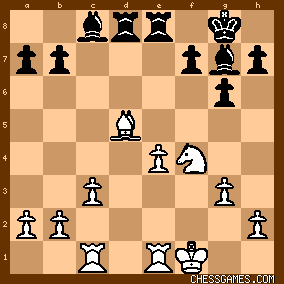| Oct-08-13 | | Marmot PFL: Black blunders a pawn away for nothing then trades down straight into a dead lost ending. Kramnik could probably have won this game blindfold. |
|
| Oct-08-13 | | Catfriend: Not according to himself.
During the press conference, he pulled long faces at various points, pointed out many possible improvements or difficulties up to the very last moves, and considered the endgame as late as move 60 "a very complex one, that must be studied". |
|
| Oct-08-13 | | Edmontonchessclub: There was some compensation for the pawn, obviously, but perhaps not enough. |
|
| Oct-08-13 | | Edmontonchessclub: It was definitely a pawn sacrifice, not a blunder. The sacrifice did not work in the end, but Goganov did intend to sacrifice the pawn. |
|
| Oct-08-13 | | dumbgai: With 9...d5 black sacrifices a pawn in exchange for active piece play. His dark square bishop has excellent scope and his knight is very active. However, black's compensation wasn't enough and white was able to trade off the rooks and reach a pawn-up minor piece endgame. |
|
| Oct-08-13 | | dumbgai: It definitely was not a blunder, as it's quite easy to calculate that white emerges a pawn up after the series of captures on d5. The position around move 9 resembles a Sicilian Dragon, an opening where the ...d5 push is a key plan for black. |
|
| Oct-08-13 | | framsey: If Goganov had played 8...d6 instead of e6, he would have reached a not uncommon position in the Dragon. |
|
| Oct-08-13 | | Marmot PFL: <It definitely was not a blunder, as it's quite easy to calculate that white emerges a pawn up after the series of captures on d5. > Technically true, but to just give away material with no other plan than to somehow draw the ending is ridiculous at this level. Kramnik has been winning endings like this since he could tie his shoes practically. |
|
| Oct-08-13 | | framsey: I have to disagree. I think he got sufficient compensation for the pawn. |
|
| Oct-09-13 | | Edmontonchessclub: It's more than "technically true". It is true.
And when you wrote that Black "blunders a pawn", you were mistaken. And when you called it "a pawn for nothing", you failed to recognize that Black got a lot of compensation for the pawn. It's rude and disrespectful to pretend that these GMs don't know how to play chess much, MUCH better than you. |
|
| Oct-09-13 | | Pulo y Gata: A very interesting game. The players reached a Dragon-type set-up where White has developed his LSB to g2. 8...e6 is atypical in this position, and 8...d6 would have reached a Sicilian structure wherein White has not gained anything significant from the opening. Black's 8th move signaled his commitment to the pawn sac, one that is easy to criticize knowing that the first player is someone named Kramnik, but Black got a lot of activity for the sacrificed pawn. 18...Ne1 would have been interesting, too, sample variation: 19.Be3 Nf3+ 20.Kg2 Be4 
click for larger view21.Bd5 Ne1+ 22.Kf1 Nc2 23.Rac1 Nxe3+ 24.fxe3 Bf5 25. Re1 Rad8 26.e4 Bc8 
click for larger viewWhite still has an extra pawn although Black's pair of Bishops could provide some chances for Black to equalize. On the game, Black must have counted on the strength of his Bishops and the relatively simplified position: in fact it's not easy to win for White after the Rooks came off the board. Kramnik taught him though: A pawn is a pawn. |
|
| Oct-09-13 | | Pulo y Gata: Maybe a save can be found for Black. But no doubt, only White could hope to win after the Rooks disappeared. |
|
| Oct-09-13 | | dakgootje: <Catfriend: Not according to himself. During the press conference, he pulled long faces at various points, pointed out many possible improvements or difficulties up to the very last moves, and considered the endgame as late as move 60 "a very complex one, that must be studied".> This is a very interesting game for postmortem comments. Suppose it was all in Russian though? |
|
| Oct-09-13 | | visayanbraindoctor: This isn't an easy ending at all.
First white has to avoid going into a BOOC situation. Kramnik did this by fixing a black pawn on f5, and then pressuring it with his bishop and knight so as to eventually force a bishop exchange, converting the ending into a knight + pawn vs bishop. While he was doing this, Kram also managed to fix the black h-pawn on h6, with a white pawn on h5, a square that the black bishop could not attack. Then he tried to attain a position wherein his extra pawn got to c6 and his king on c5. That took some maneuvering to do, but he did it. He probably already had seen such a decisive position in his chess eye before he began maneuvering. I believe that the great chess masters of history all had this 'chess eye' extremely well developed. Positions would flash in and out of their chess mind's eye and the game often becomes one of attaining one of those possible winning positions. I posted a lot of my notions on this in the Capablanca page. |
|
| Oct-09-13 | | Catfriend: <dakgootje> Aye, that is so. Maybe <polarmis> has some kind of translation, though. |
|
Oct-10-13
 | | harrylime: I like this game because after 26.Bc2 most players would be thinking draw .. Kramnik is a world champion .. respect. |
|





